Overview
This article aims to shed light on essential medical abbreviations related to Type 2 Diabetes and their importance in patient care and communication. Understanding terms like HbA1c and FBG is vital. These abbreviations not only facilitate better communication between patients and healthcare providers but also play a significant role in managing the condition effectively.
It's understandable to feel overwhelmed when navigating a new diagnosis. However, grasping these abbreviations can enhance your understanding and empower you on your journey. By fostering clearer communication, we can work together towards better health outcomes.
Remember, you're not alone in this journey. Seeking support and resources can make all the difference in managing your health. We are here to support you every step of the way.
Introduction
In the journey of managing diabetes, understanding medical terminology is essential for fostering effective communication between patients and healthcare providers. T2DSolutions stands out as a vital resource, dedicated to simplifying the often complex world of Type 2 Diabetes and its related medical abbreviations. With the prevalence of diabetes on the rise, grasping terms like A1C, BG, and FPG can truly empower individuals to take charge of their health.
It's understandable to feel overwhelmed by all this information. By promoting better communication and offering accessible resources, T2DSolutions aims to enhance patient engagement. This approach not only leads to improved health outcomes but also encourages a more informed and proactive stance in managing this chronic condition. Remember, you're not alone in this journey; we are here to support you every step of the way.
T2DSolutions: Your Guide to Type 2 Diabetes Medical Abbreviations
At T2DSolutions, we are dedicated to empowering individuals with essential knowledge about Type 2 Diabetes, including the critical role of medical abbreviations. Understanding type 2 diabetes medical abbreviations is vital for promoting efficient communication between individuals and healthcare providers, enabling them to manage their condition with confidence and precision.
Clear communication, facilitated by understanding these type 2 diabetes medical abbreviations, is essential in caring for this condition, as it directly influences individual understanding and adherence to treatment plans. It's understandable to feel overwhelmed; a study revealed that approximately 1.2 million adults were diagnosed with Type 2 Diabetes in 2021, highlighting the growing need for clear communication strategies.
With the estimated prevalence of diagnosed insulin-dependent conditions among adults remaining stable at around 8.5% from 2017 to 2021, many individuals are navigating this complex issue, which highlights the necessity for effective communication about the type 2 diabetes medical abbreviation, as real-world examples show how educational initiatives related to this condition have significantly improved individual understanding.
By simplifying complex terminology, healthcare providers can enhance individual engagement, ensuring that people feel informed about their health. This is especially important, as effective communication can lead to better health outcomes and increased satisfaction among individuals.
Educators in this field emphasize that understanding the type 2 diabetes medical abbreviation is not just helpful, but crucial for effective care. As individuals become familiar with terms like HbA1c (Hemoglobin A1c) and FBG (Fasting Blood Glucose), they are better equipped to actively participate in their care.
Statistics indicate that improved communication between patients and providers correlates with better control of the condition, reinforcing the importance of clear and accessible information.
In conclusion, T2DSolutions recognizes that understanding the type 2 diabetes medical abbreviation is a vital aspect of education regarding Type 2 Diabetes. By providing clear explanations and resources, our platform aims to bridge the communication gap between patients and healthcare providers, ultimately leading to more effective management of the condition.
As a new resource hub, T2DSolutions is committed to supporting individuals on their journey toward better health. Remember, you're not alone in this journey; we are here to support you every step of the way.

A1C: Understanding Your Hemoglobin A1c Levels
A1C, or Hemoglobin A1c, is an essential blood test that shows your average blood sugar amounts over the past two to three months, expressed as a percentage. For many adults with high blood sugar, the target A1C threshold is under 7%. Consistent tracking of A1C values is crucial. It not only assesses the success of your health care plan but also guides necessary modifications in treatment approaches.
At T2DSolutions, we strive to be your trusted source for understanding A1C values and diabetes care. Recent research emphasizes that average A1C values from the Diabetes Prevention Program vary from 5.8% to 6.2%. Keeping figures within this range is significant for optimal health outcomes. Many patients have successfully reached their A1C goals through personalized approaches, including:
- Dietary changes
- Regular physical activity
- Adherence to prescribed medications
Monitoring A1C levels is associated with enhanced management of your condition. Studies show that a significant percentage of adults are now achieving their A1C targets. This progress highlights the effectiveness of continuous education and support in managing diabetes-related care. As endocrinologists remind us, "Whether you’ve been living with this condition for years or you’re newly diagnosed, you want experts you can trust." Hemoglobin A1c testing is essential for understanding long-term glucose regulation, establishing it as a fundamental aspect of care for individuals with blood sugar issues.
Furthermore, findings presented at the American Diabetes Association’s virtual 81st Scientific Sessions emphasize the importance of A1C monitoring in diverse populations. The case study titled "Real-World Data Utilization in Diabetes Research" illustrated how real-world information can guide strategies for effectively handling blood sugar conditions.
In conclusion, understanding your A1C readings and their effects can empower you to take control of your condition, leading to improved health results and a better quality of life. At T2DSolutions, we offer resources and support to help you navigate your health journey effectively. Remember, you're not alone in this journey—we are here to support you every step of the way.
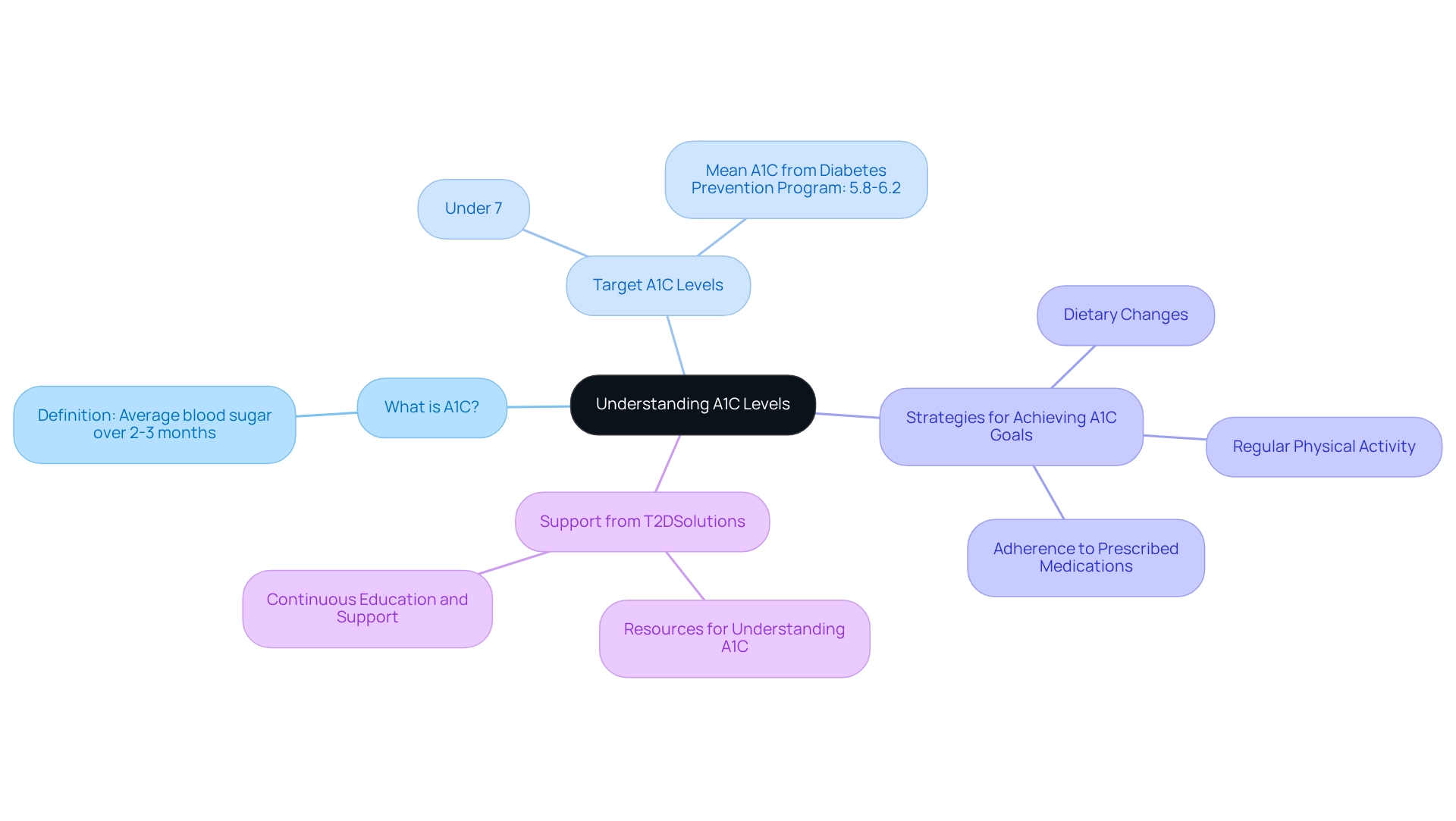
BG: The Essential Blood Glucose Measurement
BG, or blood glucose, refers to the concentration of sugar in your bloodstream. Monitoring your blood glucose is essential for effectively managing blood sugar conditions, allowing you to understand how your diet, exercise, and medications impact your health. Regular monitoring can help prevent complications such as hyperglycemia (high blood sugar) and hypoglycemia (low blood sugar), ultimately contributing to better health outcomes.
At T2DSolutions, a new resource hub dedicated to type 2 diabetes medical abbreviation health education and management, we emphasize the importance of blood glucose monitoring. In 2025, advancements in blood glucose monitoring technology have made it easier for individuals to track their readings accurately and conveniently. Research suggests that consistent monitoring is linked to improved diabetes management, with many patients reporting a significant decrease in complications when they regularly check their BG levels. For instance, a case study involving veterans revealed that using patient-generated health data through digital platforms led to enhanced care coordination and early identification of health issues. This comprehensive approach is further supported by the VA's encouragement for Veterans to share various health metrics, including blood pressure and activity levels, via the Share My Health Data app.
Moreover, the financial implications of diabetes care are considerable, with additional medical expenses per individual associated with diabetes rising from $10,179 in 2012 to $12,022 in 2022. This statistic highlights the importance of effective monitoring and management strategies to help mitigate these costs.
At T2DSolutions, we provide resources and guidance for newly diagnosed patients to effectively track their BG readings. Experts emphasize that maintaining ideal BG levels is crucial for tailoring diabetes treatment options. Seokheun Choi, an Assistant Professor, notes that "the sensitivity also is lower than conventional enzymatic biosensors," underscoring the advancements in monitoring technology. Elevated or fluctuating BG readings may require adjustments in medication or lifestyle, reinforcing the necessity of consistent monitoring. Furthermore, real-world examples show that patients who actively manage their BG values often experience improved overall health and quality of life.
In conclusion, understanding and tracking BG readings is a vital aspect of managing blood sugar conditions. It empowers you to make informed decisions about your health and treatment strategies. Remember, you're not alone in this journey; T2DSolutions is here to support you every step of the way.
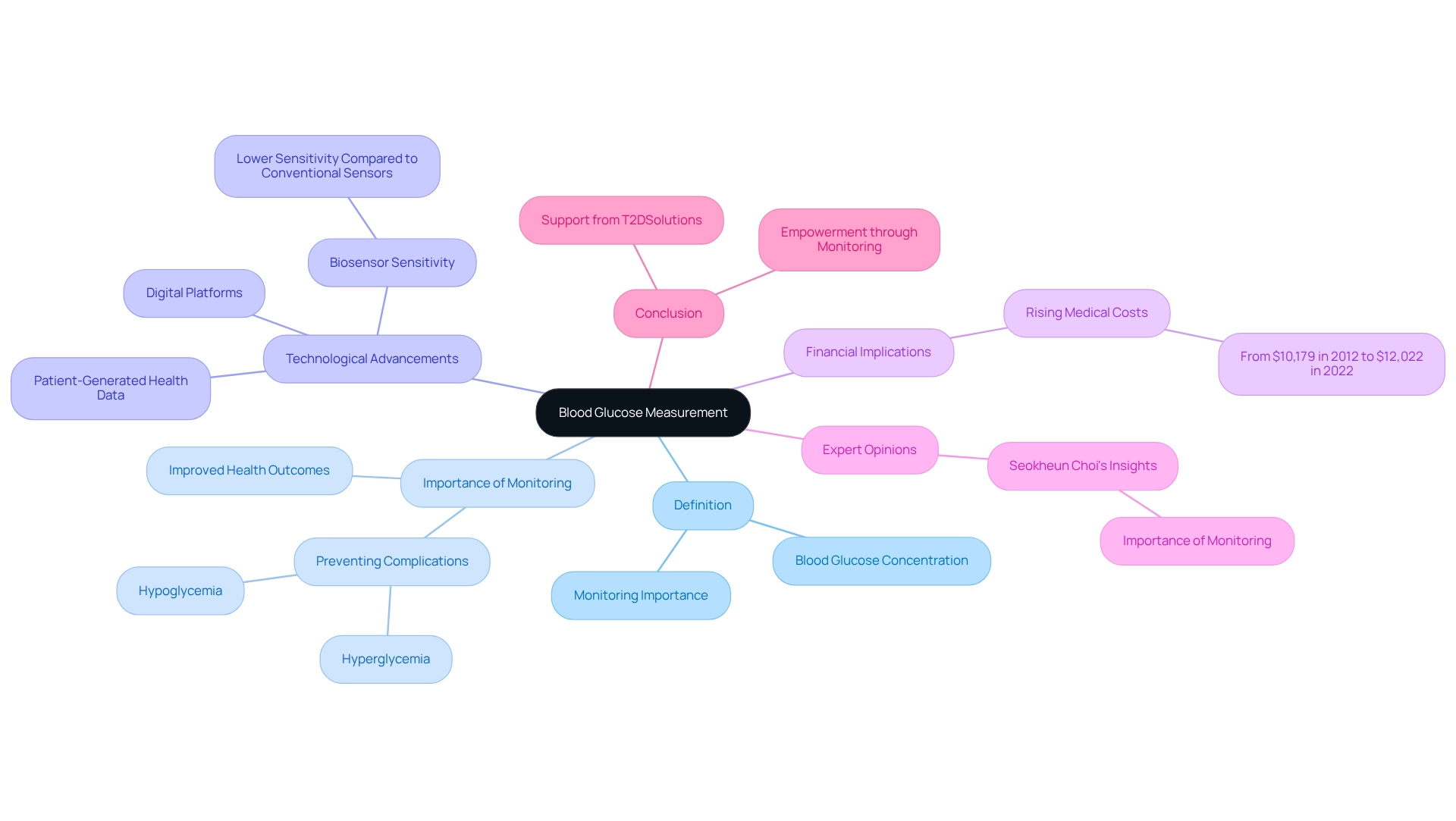
DM: The Medical Term for Diabetes Mellitus
Diabetes Mellitus (DM) is a chronic condition characterized by elevated blood sugar levels due to the body's inability to produce or effectively use insulin. This term is essential for patients, as it encompasses both Type 1 and the type 2 diabetes medical abbreviation, which together affect millions around the globe. It's important to note that approximately 537 million adults are living with this condition, with the type 2 diabetes medical abbreviation representing about 90-95% of these cases.
Understanding DM is vital for developing effective management strategies. The condition significantly influences how individuals approach their health, impacting dietary choices, exercise routines, and adherence to medication. For instance, studies have shown that dietary changes can lead to improved outcomes. One research study demonstrated that a 4- to 5-month restriction on dietary protein in individuals with early clinical nephropathy resulted in decreased albuminuria, underscoring the importance of nutrition in managing blood sugar levels.
Furthermore, case studies using animal models have shed light on the intricate relationship between genetics, diet, and the onset of diabetes. While certain dietary factors may play a role in its development, the emergence of the condition is multifactorial. As Friedman noted, "Significant alterations in the dietary choices of diabetic rodents happen later and are not causally linked to the onset of the syndrome; they may, in fact, be indicators of adaptation." This highlights the need for personalized strategies that take into account individual circumstances and health profiles.
As the prevalence of diabetes mellitus (the type 2 diabetes medical abbreviation) continues to rise, forecasts suggest that by 2045, the number of affected adults could reach 783 million. It is crucial for individuals to stay informed about the latest studies and management approaches. T2DSolutions is here to be a valuable resource for newly diagnosed patients, offering educational materials and support to help navigate their condition effectively. The connection between saturated fatty acids, dietary cholesterol, and coronary heart disease mortality in diabetics also calls for further investigation, illustrating the evolving understanding of dietary impacts on blood sugar management.
By comprehending DM and its implications, you can take proactive steps toward better health outcomes. Remember, you're not alone in this journey; we are here to support you every step of the way. Making informed decisions that align with your unique needs is key to managing your health effectively.
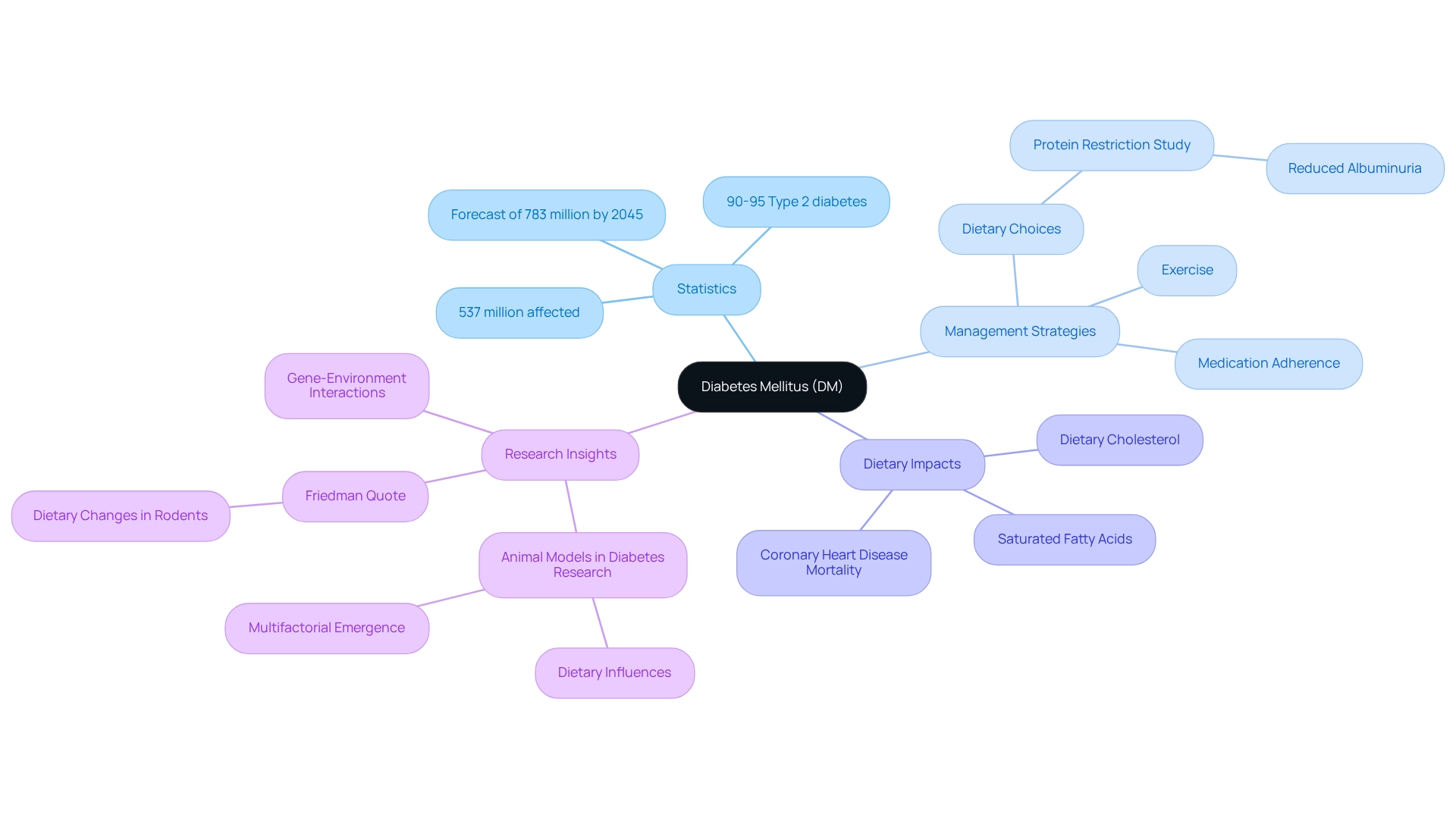
FPG: Fasting Plasma Glucose Explained
FPG, or Fasting Plasma Glucose, is an essential test that assesses blood sugar concentrations after an overnight fast. It's understandable to feel concerned about your health, and knowing that a level of 126 mg/dL or higher indicates diabetes, while levels ranging from 100 to 125 mg/dL suggest prediabetes, can be a lot to take in. This test is not only crucial for diagnosing these conditions but also plays a vital role in monitoring blood sugar control over time.
Recent updates highlight the growing importance of FPG, especially given the rising rates of blood sugar disorders among U.S. children and adolescents. The occurrence of these conditions has notably increased across all racial and ethnic groups from 2002 to 2018, underscoring the need for effective monitoring and early diagnosis. You're not alone in navigating these changes; many families are facing similar challenges.
Real-world examples show how patients use FPG to manage their blood sugar levels effectively. For instance, individuals identified with prediabetes often utilize FPG results to make lifestyle modifications, such as dietary changes and increased physical activity. These proactive steps can help prevent the progression to diabetes, fostering hope and empowerment.
Experts stress that understanding FPG results is essential for maintaining effective blood sugar control. Healthcare professionals advocate for routine observation, as ongoing evaluation of both diagnosed and undiagnosed blood sugar issues provides crucial insights into managing these conditions. As Jane A. Gwira, M.D., M.P.H. from the CDC notes, "Continued monitoring of both diagnosed and undiagnosed conditions will provide essential information about the prevalence of this illness in adults in the United States." Additionally, the overall projected expense of diagnosed sugar-related diseases in the U.S. was $327 billion in 2017, highlighting the financial strain of insufficient control.
At T2DSolutions, we recognize the significance of FPG in managing diabetes and are dedicated to offering resources and support for newly diagnosed individuals. Community-based organizations also play a crucial role in providing education and guidance for those recently diagnosed, ensuring that no one has to face this journey alone. In summary, FPG is a fundamental tool in diagnosing and overseeing blood sugar issues, helping patients and healthcare providers make informed choices about care and lifestyle changes. We encourage you to discuss your FPG results with your healthcare provider to create a personalized care plan that suits your needs.
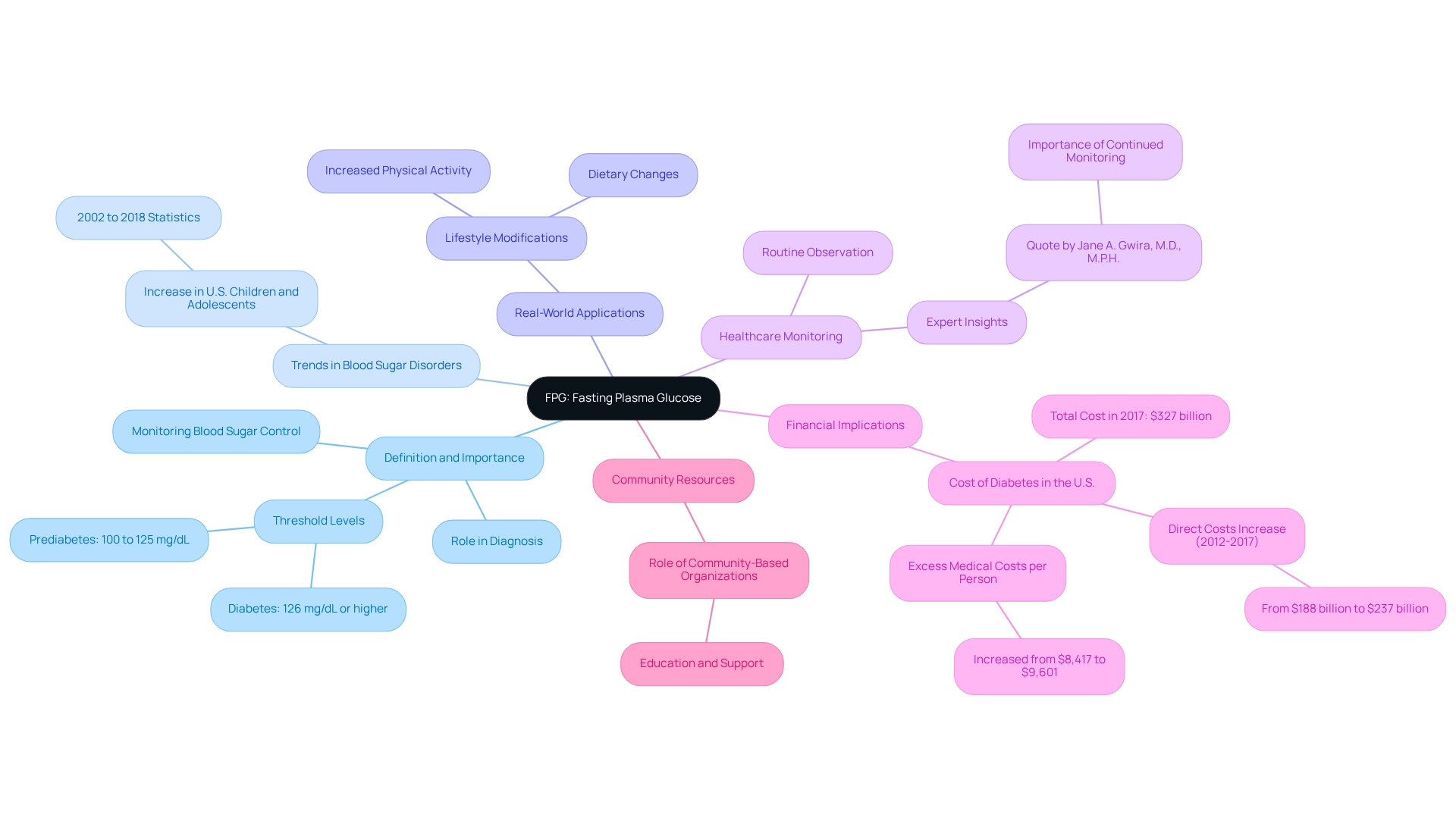
T2D: The Abbreviation for Type 2 Diabetes
T2D, or Type 2 diabetes, is the most common form of this condition. It occurs when the body becomes resistant to insulin or when the pancreas does not produce enough insulin. Unfortunately, this condition is becoming increasingly common. Recent statistics reveal a concerning rise in diabetes-related mortality rates since 2000, as highlighted in the case study titled 'Mortality Rates from Diabetes.' This trend underscores the urgent need for improved diabetes care strategies and public health initiatives, highlighting that understanding the type 2 diabetes medical abbreviation is crucial for individuals, as it frequently appears in medical literature and discussions about diabetes care. Experts emphasize that familiarizing oneself with this terminology empowers newly diagnosed individuals to engage more effectively with their healthcare providers, enabling them to make informed decisions about their treatment options.
Real-life examples demonstrate the potential for successfully managing T2D. For instance, a five-year study found that participants who achieved significant weight loss experienced remarkable health improvements, including a reduction in serious health issues compared to those receiving standard treatment. Importantly, the study participants were ethnically and geographically diverse, enhancing the relevance of these findings across various populations. This evidence supports the notion that lifestyle modifications, particularly in nutrition and physical activity, play a vital role in managing the type 2 diabetes medical abbreviation. As your understanding of the type 2 diabetes medical abbreviation deepens, it is essential to become familiar with the terminology and implications of your condition. This knowledge not only aids in navigating your healthcare journey but also encourages a proactive approach to effectively managing your condition. Additionally, T2DSolutions emphasizes the importance of personalized dietary approaches, recognizing that there isn’t a one-size-fits-all 'diabetes diet.' Tailored strategies are crucial for effective management of T2D.
To support newly diagnosed individuals, consider these practical suggestions:
- Consult with a healthcare provider to create a personalized management plan
- Engage in regular physical activity that suits your abilities
- Consistently monitor your blood sugar readings
- Learn about T2D through reliable resources, including those provided by T2DSolutions
These steps can empower you to take control of your health and enhance your quality of life.

CGM: Continuous Glucose Monitoring Technology
At T2DSolutions, we are dedicated to being a comprehensive resource center for education and support in blood sugar management, especially for those who have recently received a diagnosis. One of the key technologies we focus on is Continuous Glucose Monitoring (CGM). This revolutionary technology empowers individuals to monitor their blood glucose levels in real-time throughout the day. Not only does this groundbreaking system provide notifications for elevated or reduced blood sugar levels, but it also enables users to take proactive control of their condition.
Research shows that using CGMs can lead to improved glycemic control, with studies indicating a decrease in the coefficient of variation (CV) by approximately 3.09%. This decrease signifies more stable blood sugar levels, which is essential for the effective management of type 2 diabetes medical abbreviation.
The benefits of CGM technology extend beyond simple monitoring; it significantly reduces the need for regular fingerstick testing, alleviating a common stressor for those managing blood sugar levels. Real-world experiences reveal that CGMs serve as effective tools for enhancing self-management, especially when combined with supportive healthcare practices and community engagement. For example, a study focusing on socially marginalized patients highlighted both unique challenges and successes in using CGMs, underscoring their potential to improve patient outcomes. This aligns perfectly with our commitment at T2DSolutions to nurture resilience and hope among individuals facing health challenges, emphasizing that support is vital on this journey.
Experts in glucose management technology affirm the effectiveness of CGMs, noting that they facilitate better decision-making regarding insulin dosing and lifestyle adjustments. As one participant shared, "I think if I didn't have it, [glucose] would go back to the high levels because I wouldn't have the control." This personal insight illustrates the profound impact CGM technology can have on users' lives. As the adoption of continuous glucose monitoring technology continues to rise, its influence on blood sugar control keeps expanding, offering individuals a more holistic approach to maintaining their health.
At T2DSolutions, we are here to provide resources and assistance to help patients effectively utilize CGM technology in their health monitoring journey. Remember, you're not alone in this journey; we are here to support you every step of the way.
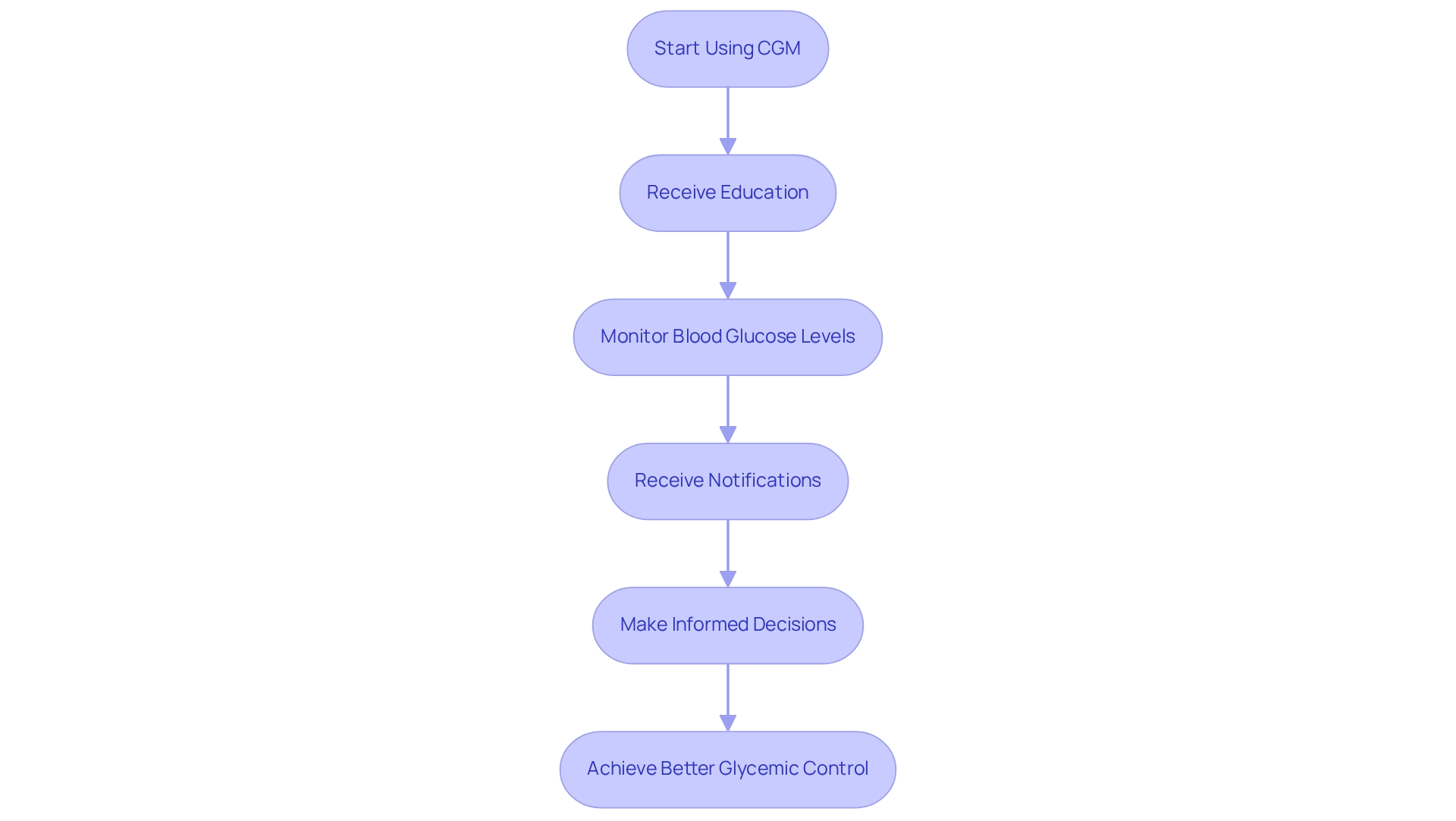
HbA1c: Another Key Measure of Blood Sugar Control
HbA1c, also known as glycated hemoglobin, is a vital marker in managing blood sugar levels, often referred to as the A1C test. This test measures the percentage of hemoglobin in the blood that has sugar attached, providing a comprehensive view of average blood sugar over the past two to three months. Understanding this long-term perspective is crucial for healthcare providers to evaluate the effectiveness of blood sugar management strategies.
At T2DSolutions, we are dedicated to empowering individuals who have recently been diagnosed with type 2 diabetes medical abbreviation by providing them with the knowledge and tools necessary for effective management of their condition. Grasping HbA1c results is essential for improving care and ensuring adherence to medications. It's important to note that HbA1c test results can vary by as much as 0.5% between different laboratories, highlighting the need for consistent monitoring and collaboration with healthcare teams.
The significance of the type 2 diabetes medical abbreviation, HbA1c testing, cannot be overstated. It is fundamental for assessing glycemic control, with expert insights emphasizing the role of the type 2 diabetes medical abbreviation in guiding treatment decisions. As Emily Eyth observes, "Hemoglobin A1c is a valuable tool in managing blood sugar disorders and other glycemic control issues." Statistics show that many individuals with diabetes undergo HbA1c testing regularly, with guidelines recommending testing every three to six months. This frequency is vital for tracking progress and making necessary adjustments to treatment plans.
Looking ahead to 2025, advancements in HbA1c testing methods continue to enhance precision and reliability, further supporting effective treatment. Current average HbA1c values among those with diabetes reveal a pressing need for improved management, as 3.4 million deaths have been linked to complications from this condition. This underscores the importance of regular monitoring; better management through consistent HbA1c testing can help prevent such outcomes.
At T2DSolutions, we provide resources and support to help individuals understand their HbA1c readings and manage their condition effectively. Real-life case studies illustrate the positive impact of regular HbA1c monitoring, showcasing instances of individuals who have achieved better blood sugar control through diligent tracking of their values. By reflecting long-term blood sugar control, HbA1c testing empowers individuals to take charge of their health and make informed decisions in partnership with their healthcare teams.
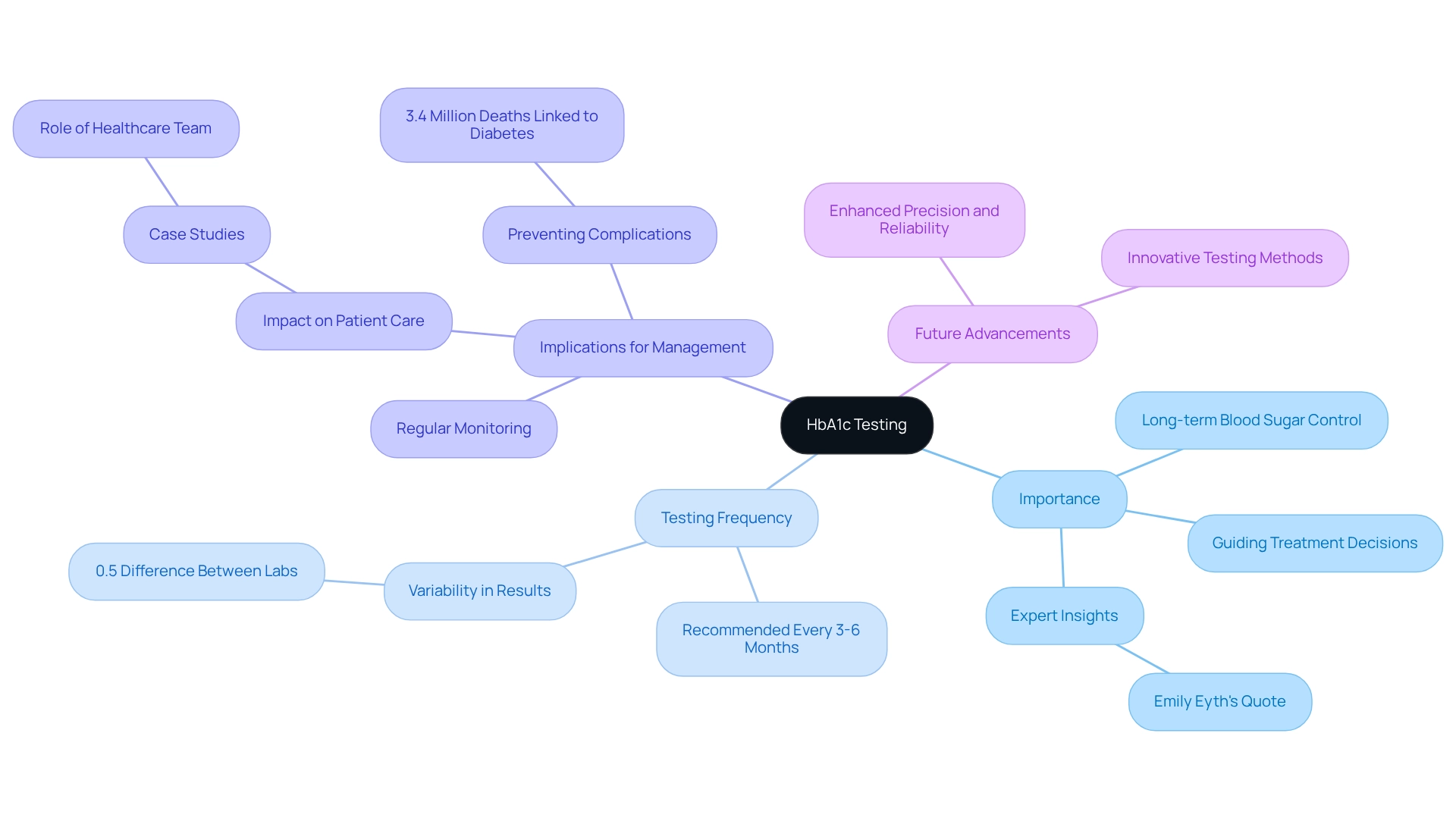
NPH: Understanding Neutral Protamine Hagedorn Insulin
NPH, or Neutral Protamine Hagedorn insulin, plays a vital role in regulating blood sugar levels for those facing challenges with high blood sugar. This intermediate-acting insulin typically begins to take effect within 1 to 3 hours after injection and maintains its action for about 10 to 16 hours. Understanding how NPH insulin works is essential for managing your insulin regimen effectively, helping you achieve optimal blood sugar control.
At T2DSolutions, we recognize how important personalized treatment plans are for your journey. Recent updates emphasize that NPH insulin remains a cornerstone in managing blood sugar levels, with studies highlighting its effectiveness across diverse populations. For example, a case study on lifestyle impacts revealed that individual choices—such as diet and physical activity—significantly affect insulin needs. This underscores the importance of tailoring strategies to fit your unique habits and routines. Additionally, specialists stress the value of understanding various insulin types, including NPH, to enhance your condition management. Endocrinologists advocate for a personalized approach, acknowledging that shared knowledge and support can lead to better health outcomes for you. Notably, combination insulin offers convenience by requiring fewer injections, simplifying treatment regimens for many.
It's also important to be mindful of potential interactions. For instance, Telmisartan has been shown to enhance the effects of NPH insulin, which highlights the need for careful monitoring. As Adam Felman noted, since the early 20th century, physicians have been isolating insulin and delivering it in injectable form to support individuals who cannot produce it independently or experience heightened insulin resistance.
To assist you in managing your condition, T2DSolutions offers resources and community support to help you understand how NPH insulin functions and its duration of action. Regular consultations with your healthcare provider are crucial for adjusting your insulin regimen based on your lifestyle and any medications you may be taking. By utilizing the resources available at T2DSolutions, you can make informed decisions about your treatment strategies. Remember, you're not alone in this journey; we are here to support you every step of the way.

SGLT2: Sodium-Glucose Co-Transporter 2 Inhibitors
At T2DSolutions, we understand that navigating diabetes can feel overwhelming. That's why we strive to be a comprehensive resource hub for diabetes education and management.
Have you heard of SGLT2? It stands for Sodium-Glucose Co-Transporter 2, a class of medications designed to help lower blood sugar levels by preventing glucose reabsorption in the kidneys. These inhibitors not only improve glycemic control but also provide cardiovascular and renal benefits, making them a valuable option for many patients, as indicated by the type 2 diabetes medical abbreviation.
For more information on managing your diabetes and understanding your treatment options, we invite you to explore the resources available at T2DSolutions. We are here to support you every step of the way.
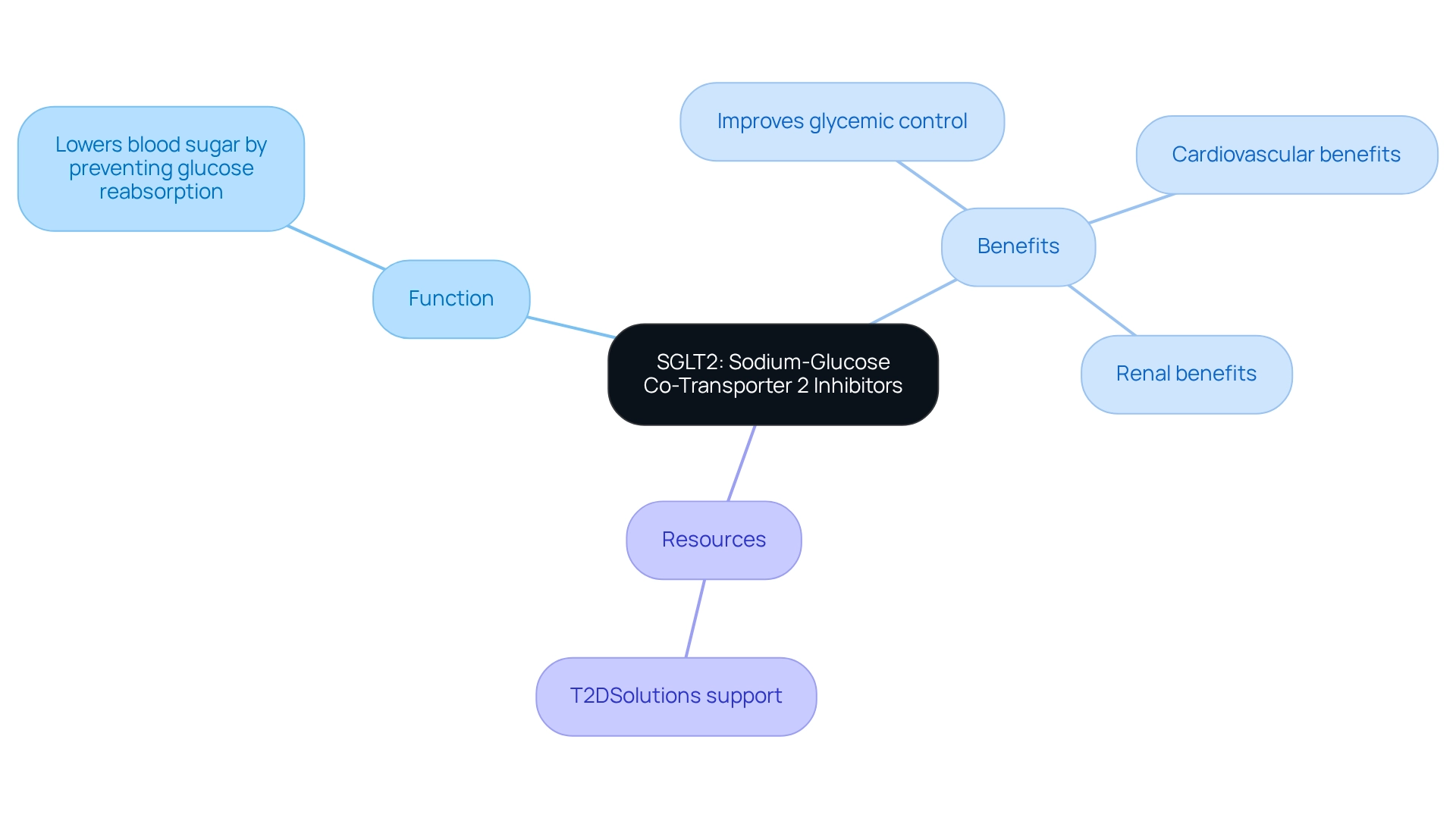
Conclusion
Understanding medical terminology and abbreviations related to Type 2 diabetes is crucial for effective diabetes management. At T2DSolutions, we provide essential resources that empower you to navigate your health with confidence. By familiarizing yourself with terms such as A1C, BG, FPG, and others, you can enhance your communication with healthcare providers, leading to better understanding and adherence to treatment plans.
The importance of clear communication in diabetes care cannot be overstated. As diabetes rates continue to rise globally, the need for accessible education becomes increasingly vital. T2DSolutions is dedicated to bridging the knowledge gap, ensuring that you have the tools you need to actively participate in your health management. This proactive engagement not only improves health outcomes but also fosters a supportive community for individuals living with diabetes. You're not alone in this journey.
In conclusion, mastering these medical abbreviations and understanding their implications is a key aspect of managing Type 2 diabetes. By utilizing the resources offered by T2DSolutions, you can take meaningful steps towards better health, making informed choices that align with your unique needs. Empowerment through knowledge is the foundation of effective diabetes management, and we are here to support you every step of the way.
Frequently Asked Questions
Why is understanding medical abbreviations important for individuals with Type 2 Diabetes?
Understanding medical abbreviations is vital for promoting efficient communication between individuals and healthcare providers, enabling better management of the condition and adherence to treatment plans.
What impact does clear communication have on managing Type 2 Diabetes?
Clear communication influences individual understanding and adherence to treatment plans, leading to better health outcomes and increased satisfaction among individuals.
What was the statistic regarding Type 2 Diabetes diagnoses in 2021?
Approximately 1.2 million adults were diagnosed with Type 2 Diabetes in 2021, highlighting the growing need for clear communication strategies.
What is A1C, and why is it significant for diabetes management?
A1C, or Hemoglobin A1c, is a blood test that shows average blood sugar levels over the past two to three months. It is significant because it helps assess the success of healthcare plans and guides necessary treatment modifications.
What are the target A1C levels for adults with high blood sugar?
The target A1C threshold for many adults with high blood sugar is under 7%.
How can individuals manage their A1C levels effectively?
Individuals can manage their A1C levels through dietary changes, regular physical activity, and adherence to prescribed medications.
What does BG stand for, and why is monitoring it important?
BG stands for blood glucose, which refers to the concentration of sugar in the bloodstream. Monitoring BG is essential for managing blood sugar conditions and preventing complications.
What advancements have been made in blood glucose monitoring technology?
Advancements in blood glucose monitoring technology have made it easier for individuals to track their readings accurately and conveniently.
How has the financial burden of diabetes care changed from 2012 to 2022?
The additional medical expenses per individual associated with diabetes rose from $10,179 in 2012 to $12,022 in 2022.
What resources does T2DSolutions provide for individuals managing Type 2 Diabetes?
T2DSolutions offers resources and guidance for understanding medical abbreviations, tracking A1C and BG readings, and effectively managing diabetes care.



